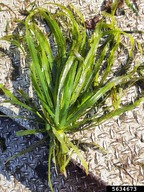| water soldier | USDA PLANTS Symbol: STAL6 U.S. Nativity: Habit: Aquatic Plants Forbs/Herbs |
| Stratiotes aloides L. |
Jump to: Resources | Images | Distribution Maps | Sources
|
Taxonomic Rank: Liliopsida: Hydrocharitales: Hydrocharitaceae |
|
| Synonym(s): water soldiers, Water-aloe | |
|
|
Identification, Biology, Control and Management Resources
|
| Selected Images from Invasive.org | View All Images at Invasive.org |
 Plant(s); Submersed. Shaun Winterton, California Department of Food and Agriculture, Bugwood.org Additional Resolutions & Image Usage |
 Plant(s); While running leaders on hoop nets we finally looked closely at the plants that were coming up in them. There were lots of them and they are obviously being carried by the current that has been strong this spring. Joanne Dewey, , Bugwood.org Additional Resolutions & Image Usage |
| EDDMapS Distribution: This map is incomplete and is based only on current site and county level reports made by experts and records obtained from USDA Plants Database. For more information, visit www.eddmaps.org |
 State List This map identifies those states that list this species on their invasive species list or law. 
|
| Invasive Listing Sources: |










